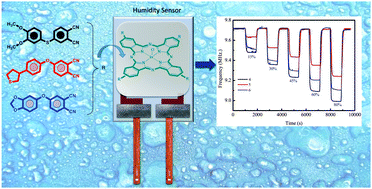Novel indium(iii) phthalocyanines; synthesis, photophysical and humidity sensing properties
Abstract
Three new 3,4-(dimethoxyphenylthio) (4), 4-(thiophen-3yl)phenoxy (5), 3,4-(methylendioxy)phenoxy (6) substituted chloroindium(III) phthalocyanines were synthesized and characterized. The indium(III) phthalocyanine derivatives were characterized by using spectroscopy methods, FT-IR, 1H-NMR spectroscopy, electronic spectroscopy and mass spectra as well as elemental analysis. The photophysical properties (fluorescence quantum yields and fluorescence behavior) of their peripherally tetra-substituted new complexes (4 to 6) have been examined. General trends focus on fluorescence behavior, photophysical and electronic properties as well as the humidity sensing ability of these compounds in dimethylsulfoxide (DMSO), dimethylformamide (DMF) and tetrahydrofuran (THF). Complexes (4 to 6) showed reasonably higher fluorescence quantum yields ranging from 0.050 to 0.092 in DMF, 0.029 to 0.084 in DMSO and 0.023 to 0.060 in THF compared to other indium derivatives in the literature. The nature of the substituent and solvent effects on the electronic and photophysical parameters of the three different substituted indium(III) phthalocyanines (4–6) are also reported. The humidity detection capabilities of the 4–6 films have also been investigated. Comparing humidity-sensing properties of the Pcs, it was found that the humidity sensitivity of 4 is higher than 5 and 6.


 Please wait while we load your content...
Please wait while we load your content...